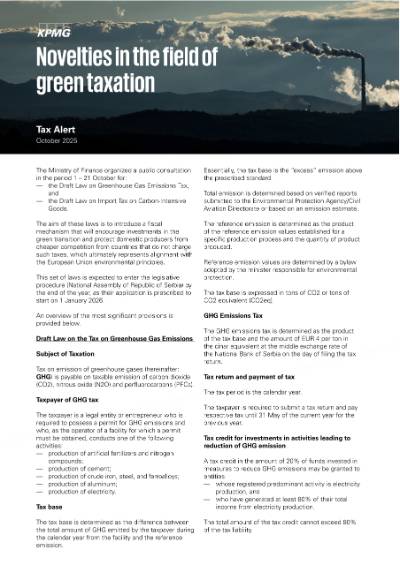The Ministry of Finance organized a public consultation in the period 1 – 21 October for:
- the Draft Law on Greenhouse Gas Emissions Tax, and
- the Draft Law on Import Tax on Carbon-Intensive Goods.
The aim of these laws is to introduce a fiscal mechanism that will encourage investments in the green transition and protect domestic producers from cheaper competition from countries that do not charge such taxes, which ultimately represents alignment with the European Union environmental principles.
This set of laws is expected to enter the legislative procedure (National Assembly of Republic of Serbia) by the end of the year, as their application is prescribed to start on 1 January 2026.
An overview of the most significant provisions is provided below.
Draft Law on the Tax on Greenhouse Gas Emissions
Subject of Taxation
Tax on emission of greenhouse gases (hereinafter: GHG) is payable on taxable emission of carbon dioxide (CO2), nitrous oxide (N2O) and perfluorocarbons (PFCs).
Taxpayer of GHG tax
The taxpayer is a legal entity or entrepreneur who is required to possess a permit for GHG emissions and who, as the operator of a facility for which a permit must be obtained, conducts one of the following activities:
- production of artificial fertilizers and nitrogen compounds;
- production of cement;
- production of crude iron, steel, and ferroalloys;
- production of aluminum;
- production of electricity.
Tax base
The tax base is determined as the difference between the total amount of GHG emitted by the taxpayer during the calendar year from the facility and the reference emission.
Essentially, the tax base is the “excess” emission above the prescribed standard.
Total emission is determined based on verified reports submitted to the Environmental Protection Agency/Civil Aviation Directorate or based on an emission estimate.
The reference emission is determined as the product of the reference emission values established for a specific production process and the quantity of product produced.
Reference emission values are determined by a bylaw adopted by the minister responsible for environmental protection.
The tax base is expressed in tons of CO2 or tons of CO2 equivalent (CO2eq).
GHG Emissions Tax
The GHG emissions tax is determined as the product of the tax base and the amount of EUR 4 per ton in the dinar equivalent at the middle exchange rate of the National Bank of Serbia on the day of filing the tax return.
Tax return and payment of tax
The tax period is the calendar year.
The taxpayer is required to submit a tax return and pay respective tax until 31 May of the current year for the previous year.
Tax credit for investments in activities leading to reduction of GHG emission
A tax credit in the amount of 20% of funds invested in measures to reduce GHG emissions may be granted to entities:
- whose registered predominant activity is electricity production, and
- who have generated at least 80% of their total income from electricity production.
The total amount of the tax credit cannot exceed 80% of the tax liability.
The tax credit can be used in a 10-years period starting from 2026.
Law on Import Tax on Carbon-Intensive Goods
Subject of taxation
The subject of taxation is the import of carbon-intensive products into the Republic of Serbia.
A carbon-intensive product is a good that falls into one of the following categories:
- Iron and steel,
- Cement,
- Fertilizer, and
- Aluminum.
Taxpayer
The taxpayer is:
- an entity that imports a carbon-intensive product in its name and on its behalf,
- an entity on whose behalf a carbon-intensive product is imported into the Republic of Serbia.
Entities who have imported less than 5 tons of a carbon-intensive product during a calendar year are not considered as taxpayers.
Tax base
The tax base is defined as:
the actual amount of CO2eq emissions related to a carbon-intensive product, confirmed in the validator’s report, reduced by the reference amount of emissions; or
the estimated amount of CO2eq emissions related to a carbon-intensive product, in cases where the validator is, for any reason, unable to confirm the actual amount of CO2eq emissions.
The reference emission is determined as the product of the reference emission values established for a specific production process and the quantity of product produced.
Estimated amount of CO2eq emissions related to an individual carbon-intensive product is determined as the product of the quantity of the imported carbon-intensive product and the default CO2eq emission values, measured in tons of CO2eq per ton of the carbon-intensive product.
Reference and default emissions values are determined by a bylaw adopted by the minister responsible for environmental protection.
Tax on import of carbon-intensive goods
Tax is determined as the product of the tax base and the amount of EUR 4 per ton in the dinar equivalent at the middle exchange rate of the National Bank of Serbia on the day of filing the tax return.
Tax return and payment of tax
The tax period is the calendar year.
The taxpayer is required to submit a tax return and pay respective tax until 31 May of the current year for the previous year.
Tax credit
The taxpayer is entitled to reduction of tax liability if payment has already been performed in the country of origin for the same product for the manufacture of a carbon-intensive product.
In order to exercise the right to a tax credit, the taxpayer must provide evidence of payment, the amount of the fee paid, the quantity of emissions, the calculation methodology and the time period to which the payment refers.
The tax credit can be used in the year of import or in the following fiscal year.
The tax credit can be used in a 10-years period starting from 2026.
For previous editions of KPMG Tax Alerts please visit the following web page:
KPMG Tax & Legal Department
KPMG d.o.o. Beograd
Milutina Milankovića 1J
11 070 Belgrade, Serbia
T: +381 11 20 50 500
F: +381 11 20 50 550
tax@kpmg.rs

